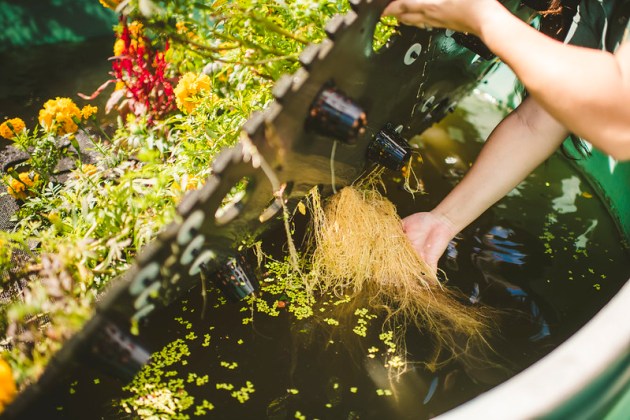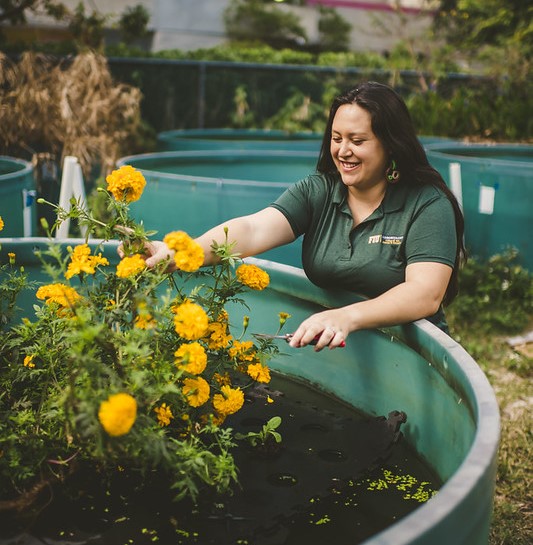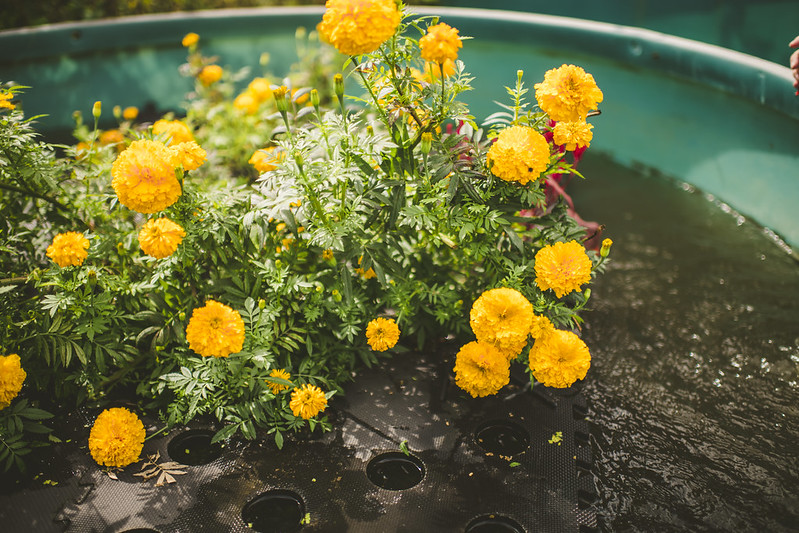Jazmin Locke-Rodriguez has a new favorite flower in her South Florida garden. She’s looking at it as she explains her research process for the dissertation she recently defended at Florida International University in Miami. She describes the bold blooms with something close to awe.
“I have gravitated toward the golden ones,” says Jazmin Locke-Rodriguez, Florida International University post doctorate associate. “The color is between yellow and orange and they’ve done the best for me. I like that in between tone. They look like sunshine to me.”
Her “sunshine” is marigolds and they serve dual purpose with future potential that’s as bright as their color. Locke-Rodriguez planted flowers – zinnias, sunflowers and giant marigolds – on mats floating in polluted water, similar to the nutrient-loaded runoff found in the Everglades and in urban areas of South Florida.
Each variety floated in its own round tank that was about the size of a large kiddie pool you fill with a hose in your backyard for summer fun.
The zinnias and sunflowers struggled, dying before the 12-week study ended. Sunflowers tapped out at three weeks, zinnias at five weeks. The marigolds, however, lasted 12 weeks. They thrived and they bloomed, removing 52 percent more phosphorus and 33 percent more nitrogen as Locke-Rodriguez discusses in this video.
Cleaning polluted water was the primary purpose, but as they grew their other purpose blossomed.

Wetlands That Float
“I’m from Miami. I grew up on the water. Early on, I learned about devastating impacts of nutrient pollution,” Locke-Rodriguez says. “I leaned into agriculture and finding ways to reduce ag nutrient runoff. I also wanted to find a way to create a sustainable operation and create jobs. When I envision what this looks like on a large scale, I see a way for us to sustainably farm and create local products by pushing the envelope for the environment.”
By pushing the envelope, she means thinking outside the box. She’s growing something different on the mats, but she’s not the first to use floating mats on water to grow plants. Aztecs did it centuries ago.
They called them chinampas, but the goal wasn’t reducing pollutants. The goal was irrigation for artificial islands. Ancient engineers built and cultivated islands as garden plots directly on top of the water allowing enough space between each plot for navigating a canoe during a day’s work in the field.
Modern-day mats, also known as floating treatment wetlands (FTWs) are planted with traditional wetland vegetation. They reduce water pollution well enough but that’s it. They’re planted and left to their own cleaning devices. Locke-Rodriguez is going one creative step further. She’s gardening with what she calls productive FTWs because her mats grow flowers for sale.
“We’re choosing flowers that are cut and come again,” she says. “The more you harvest them, the more blooms you get. We promote new growth and that promotes more nutrient intake to clean the water even more. We want to produce as many flowers as possible.”
One Flower, Two Purposes
Those cut flowers emerge as her second purpose for FTWs. They can be sold, creating more flower farm jobs and contributing to the $3.3 billion fresh-cut floral market. Marigolds are similar to chrysanthemums, which wholesale for about $1 per bloom. The nearly two dozen marigolds in the study produced 65 large blooms in 12 weeks.
With Miami receiving 80 percent of cut flowers imported into the U.S. and Florida being the highest producer of cut greens used in bouquets, there’s no doubt mat-grown marigolds would sell.

“There is a niche for them. There’s value for them,” Locke-Rodriguez says, “I’ve done farmers markets for the past couple of week testing people’s reaction to them. I’ve had incredible responses to them.”
Marigolds hold a special place in human history for many cultures. They decorate altars. They’re worn as garlands. They hang as wreaths. In India, they’re displayed by the thousands with ceremonial and religious importance, especially at weddings. Marigolds symbolize joy and prosperity.
In Europe, Mary’s Gold, now known as marigold, was chosen as an offering to the Virgin Mary. In Mexico, marigolds are the flower of choice for Dia De Los Muertos, or Day of the Dead. Festival worshippers believe the color and scent of marigolds guides home the souls of those who have passed on.
And in Florida, Locke-Rodriguez hopes one day they’ll also be known as pollution fighters and bestsellers that are locally grown while floating on mats in waterways.
“I’m an advocate for using them more. They really hold a special place in our toolkit because wetlands are the filtering environment for our earth and we’re losing them by the hundreds of acres,” she says. “This is not just a southwest Florida solution. They can help around the world wherever there is water. This is just the beginning.”




Join the Discussion